|
|
|
Sort Order |
|
|
|
Items / Page
|
|
|
|
|
|
|
| Srl | Item |
| 1 |
ID:
181697
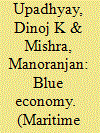

|
|
|
|
|
| Summary/Abstract |
Blue economy, which promotes sustainable usages of ocean resources for economic growth and development, as well as preservation of the health of ocean ecosystem, has become a crucial element of the broader ecosystem of sustainable and inclusive development. The desire to sustainably harness the potential of ocean and marine resources has been amply visible at the national and global level. Technological innovations, investment and multilateral cooperation have further been facilitating progress in the sectors of blue economy. Placed in a central position in the Indian Ocean and with a vast exclusive economic zone (EEZ), India has substantial potential for tapping marine resources and blue economy could emerge as the paradigm of development in the future. New Delhi has taken many initiatives to promote blue economy activities and development of modern infrastructure for greater connectivity, international collaboration and trade facilitation. Further, it is seeking wider multilateral cooperation in areas of financing, technology transfer, capacity building and knowledge sharing. This paper underlines the importance of blue economy in a broader framework of sustainable development and analyses India’s foreign policy orientation towards blue economy. Finally, it also discusses cooperation between India and European countries in the sectors of blue economy.
|
|
|
|
|
|
|
|
|
|
|
|
|
|
|
|
| 2 |
ID:
181702
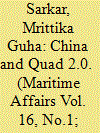

|
|
|
|
|
| Summary/Abstract |
The existing literature on the Quadrilateral Initiative or Quad 2.0, has primarily focused on why the US, India, Japan and Australia have been promoting a strategic mechanism and how it could possibly contain an increasingly assertive China in the Indo-Pacific. However, what remains overlooked is the Chinese perception towards the Quad, which remains complex and systemic, underpinned by Beijing’s national interests, national identity in the regional affairs, and a desire to attain the “Chinese Dream”. While the official Chinese reaction to the “Asian NATO” has mainly been dismissive, this paper argues that Beijing’s response to the Quad with its underlying apprehensions, is structurally linked to China’s rise vis-à-vis India, the re-emergence of Japan in Asia and beyond, Australia’s recent firm and calculated approach towards China, and US’ rebuilt Asia strategy extending beyond military connotations.
|
|
|
|
|
|
|
|
|
|
|
|
|
|
|
|
| 3 |
ID:
181698
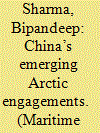

|
|
|
|
|
| Summary/Abstract |
Climate induced geo-physical transformations occurring in the Arctic are also attributing to geopolitical transformations of the region. Opening up of the Arctic is resulting in a geopolitical race amongst the Arctic and non-Arctic states to dominate emerging economic and strategic opportunities in the region. Transformations in the Arctic assume global links and possess a potential of significantly impacting the Arctic as well as the Asian states. China’s assertiveness to become a Polar Great Power has set a course for new Asian perceptions towards the region. In pursuits of its economic, environmental, scientific, social and strategic endeavours, China is making significant inroads in the region to meet its short and long-term objectives. This paper makes an attempt to reconsider India’s approach towards the Arctic not by taking China as a benchmark, but rather as a useful backdrop to broaden and deepen India’s engagements in the circumpolar north.
|
|
|
|
|
|
|
|
|
|
|
|
|
|
|
|
| 4 |
ID:
181695
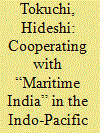

|
|
|
|
|
| Summary/Abstract |
The main purpose of this article is to identify a common basis for Japan and India as maritime democracies to work together for the maintenance and enhancement of the rules-based liberal international order at sea in the face of a variety of challenges in the Indo-Pacific region, China’s maritime advancement in particular. As powerful maritime democracies in the Indo-Pacific, Japan and India will be able to engage in a wide variety of maritime security cooperation. The opinions of security experts of both countries should be mustered so that bilateral cooperation keeps up its momentum. Synergy of Tracks 1, 1.5 and 2 dialogues should be pursued for maritime security cooperation. In this bilateral effort, the US-centred alliance network, of which the Japan-US Alliance is the central portion, and India’s autonomous and multi-directional approach toward international security must be intertwined effectively. Also, security dialogues between the two countries and between the two navies should work out the division of labour between Japan and India to contribute to the Indo-Pacific regional maritime security more effectively.
|
|
|
|
|
|
|
|
|
|
|
|
|
|
|
|
| 5 |
ID:
181701


|
|
|
|
|
| Summary/Abstract |
Japan has had and continues to have a diverse set of interests pertaining to South Asia and the vast expanse of the Indian Ocean Region. The article below assesses the emerging maritime interests of Japan in the Indian Ocean and aspects of maritime security, maritime cooperation, infrastructure investments, food security, etc. and attempts to devise an approach for Japan in the twenty-first century security scenarios of the world’s third largest ocean. The Indian Ocean is responsible for the passage of Japan’s imports of oil, 90 percent of which are sourced from the oil-rich region of the Arabian Gulf. While the criticality of the Indian Ocean in terms of security threats such as piracy and armed robbery remains considerably behind the Pacific Ocean’s and other critical sea bodies such as the South and East China Seas, a strategy for India, the Indian Ocean, and South Asia befits the drawing up of avant-garde strategies, doctrines, operational and tactical prowess.
|
|
|
|
|
|
|
|
|
|
|
|
|
|
|
|
| 6 |
ID:
181700


|
|
|
|
|
| Summary/Abstract |
In this paper, we argue that China is seeking to establish a balance of power favourable to its interests in South Asia and the adjoining waters to curtail India’s rise. Military balancing, economic engagement, and the new multi-regional connectivity project – the “Belt and Road Initiative” – are the key components of China’s policy against India. By roping in the South Asian and the Indian Ocean states, China has effectively deployed the “string of pearls” strategy with an express purpose to box-in India within the region so that it cannot challenge China’s primacy in Asia and beyond. To neutralise Beijing’s assertive activities, New Delhi has evolved its Asia policy with a clear motive to enhance its ties with the key Indo-Pacific states – the US, Japan, Australia, and the Southeast Asian countries – so that it could develop counter-leverages against China and simultaneously manage its rise as a major Indo-Pacific power. Given that both India and China are vying for similar power position in the same region, it is highly likely that their clashing interests might intensify their power competition in the near future.
|
|
|
|
|
|
|
|
|
|
|
|
|
|
|
|
| 7 |
ID:
181696


|
|
|
|
|
| Summary/Abstract |
Japan is heavily dependent on the Sea Lanes of Communications (SLOCs) of the South China Sea for its external trade including the critical energy imports from the Persian Gulf region. Any kind of instability or disruption over the contested waters will have an adverse effect on Japan's trade and economy. The increasingly assertive actions of Beijing, especially the military buildup have raised concerns in Tokyo as it might eventually lead to the strategic control of the SLOCs. Thus, developments in the South China Sea are a major reason why Japan has brought about several changes to its defence and security policies. This paper will explore how Chinese assertions in the South China Sea have encouraged Japan to steadily revise its security policies in a more fundamental way since the end of World War II.
|
|
|
|
|
|
|
|
|
|
|
|
|
|
|
|
| 8 |
ID:
181699
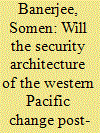

|
|
|
|
|
| Summary/Abstract |
The Indo-Pacific, combines a panoply of regions and blends multiple security architectures. Some regions are dominated by non-traditional security threats, while others are unstable and rife with security dilemma. Instability and disorder are most palpable in the maritime domain, especially in the geographical region of the western Pacific. From the beginning of 2020, China has intensified its assertiveness in the South China Sea, including the announcement of two administrative districts and transgressions by its survey ship Haiyang Dizhi 8. Some attribute these developments to the COVID-19 outbreak. Enhanced US posture in the region seems to have little effect on Chinese revanchism. This article assesses the spurt of developments in the South China Sea during the COVID-19 pandemic. It establishes the conceptual framework for analysing the change in the regional order. It evaluates the regional security architecture of the western Pacific and the efficacy of the putative order. The prospective change in the security order of the western Pacific and response is also examined.
|
|
|
|
|
|
|
|
|
|
|
|
|
|
|
|
|
|
|
|
|